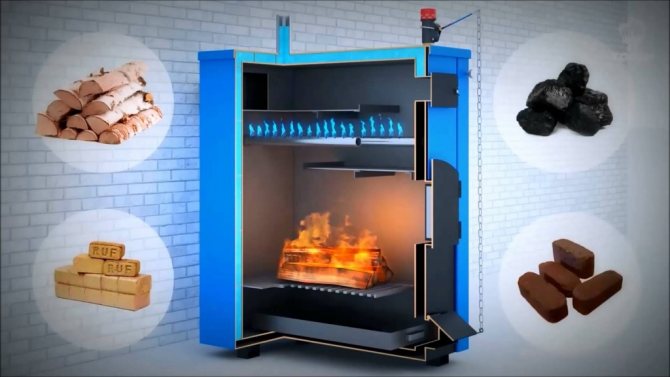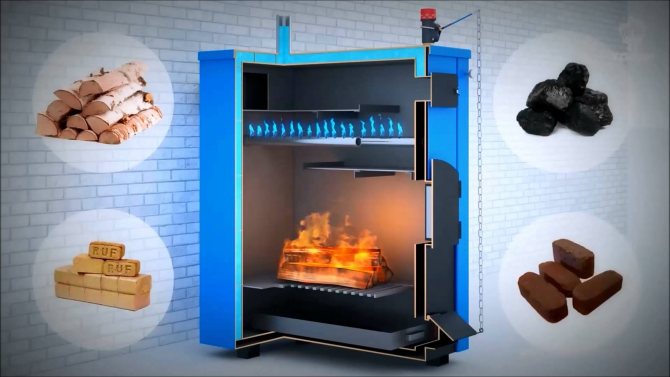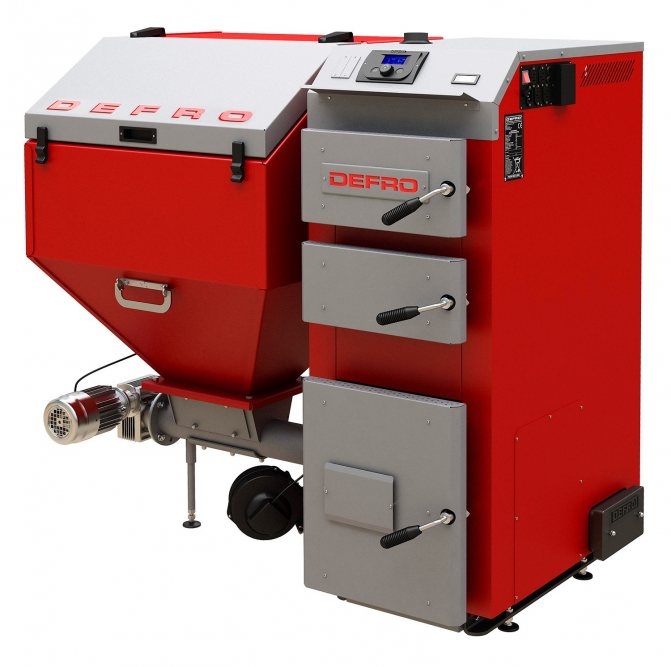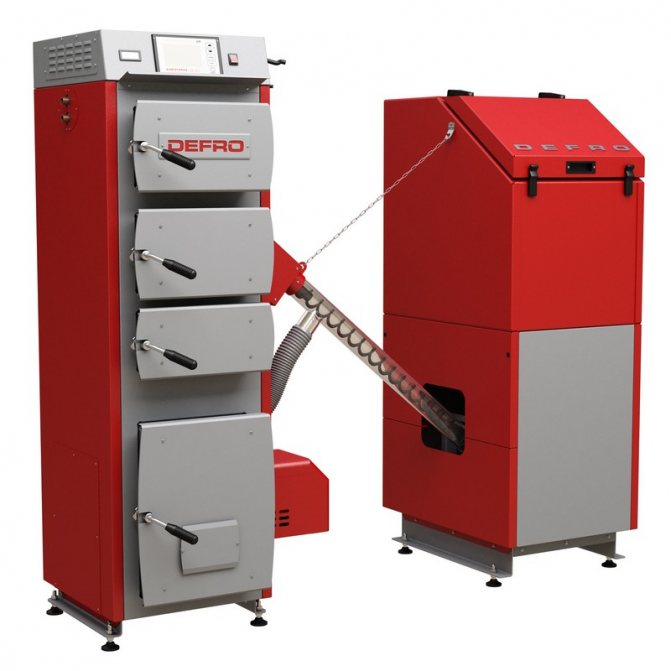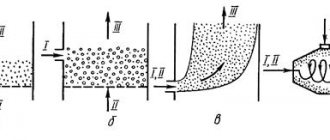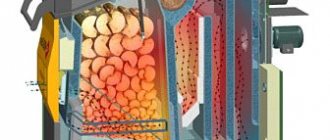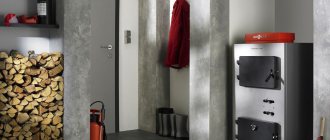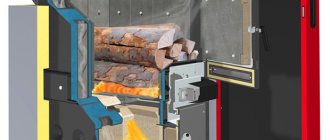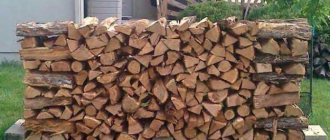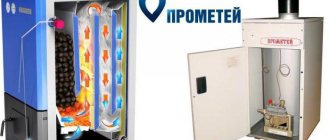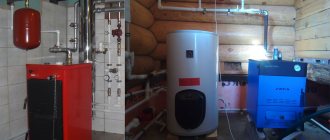Briefly about pyrolysis combustion
The pyrolysis process is the slow decomposition of carbon fuels, which occurs under the influence of high temperatures with a lack of oxygen. Combustible gas or liquid fuel is obtained at the exit, depending on the feedstock and the conditions of the chemical reaction.
Pyrolysis heating boilers produce and burn exactly gas, hence the second name - gas generating or gasifying. Initial raw materials - dry firewood, coal, fuel briquettes.

Diagram of a gas generator plant that produces fuel for an internal combustion engine
Reference. A wide variety of solid fuels containing hydrocarbon compounds are used for pyrolysis combustion. An example is the production of liquid fuel from old car tires or the incineration of waste in industrial gas-fired ovens.
How wood pyrolysis occurs:
- A certain volume of chopped wood or sawdust is loaded into a closed tank (reactor).
- The metal vessel is heated from the outside up to 500 ... 900 ° C, air is supplied through the tuyeres (blowing holes) limitedly.
- Wood smolders and decomposes into its constituents - hydrogen, methane, carbon monoxide, water vapor, carbon dioxide. At the end of the reaction, some ash remains at the bottom.
- The resulting gas mixture is cooled, cleaned, and then pumped into cylinders for further use.
Before loading into the gas generator, the wood is dried. Otherwise, the heating energy will be spent on the evaporation of water, the pyrolysis reaction will slow down greatly, and we will get a bunch of water vapor at the exit.
Note that any process of burning solid fuel is accompanied by the release of wood gas, even in a fire (see the photo). Pyrolysis is described in more detail in our other publication.
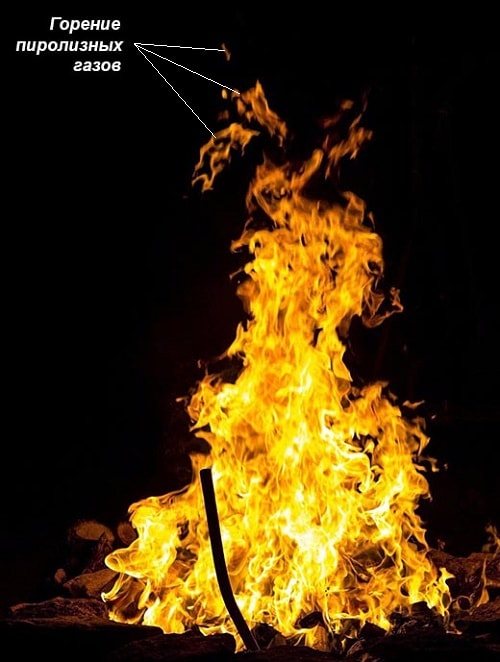

Long-burning solid fuel pyrolysis gas-fired boilers
The operation of such boilers is based on fuel gasification. The furnace of such a boiler is divided into 2 halves horizontally. The upper half, which is also a loading chamber for fuel, the wood does not burn, but smolders. Experiencing the effects of high temperatures, firewood emit various combustible substances, which become the main fuel for the boiler, burning in the second chamber located at the bottom.


The described principle of operation of boilers significantly increases the efficiency of such samples, in this case we can talk about 85 or even 90%. The burning time of the fuel also increases significantly, reaching up to 12 hours. The fact is that in the boilers under consideration, the process of direct fuel combustion occurs only in the lower chamber.
In the upper, loading chamber, firewood only smolders, emitting flammable substances. After that, the combustible substances are mixed with air and, through a special nozzle, are sent to the second, lower chamber, where they become the main fuel for such a boiler. In the process of burning a mixture of air and gases released from firewood, it is possible to achieve sufficiently high temperatures, therefore, the lower chamber, in which the combustion process takes place, is sheathed with a special heat-resistant finish.
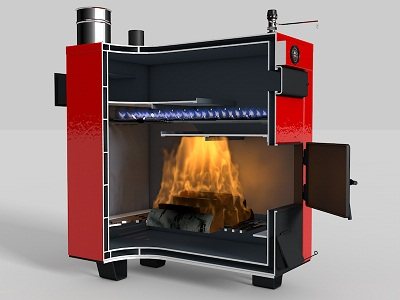

The fuel in the boilers under consideration burns out almost completely, which also allows us to talk about the boiler's efficiency. In addition, due to its technical features, the boiler does not form soot and ash during operation. In order for the pyrolysis boiler to fully perform its functions, it is necessary to fully pump air into the device.
The boilers in question are complex and expensive equipment. In most cases, the design of such boilers includes:
- Smoke exhausters;
- Electronic devices for the control of the boiler working process and effective control over it.
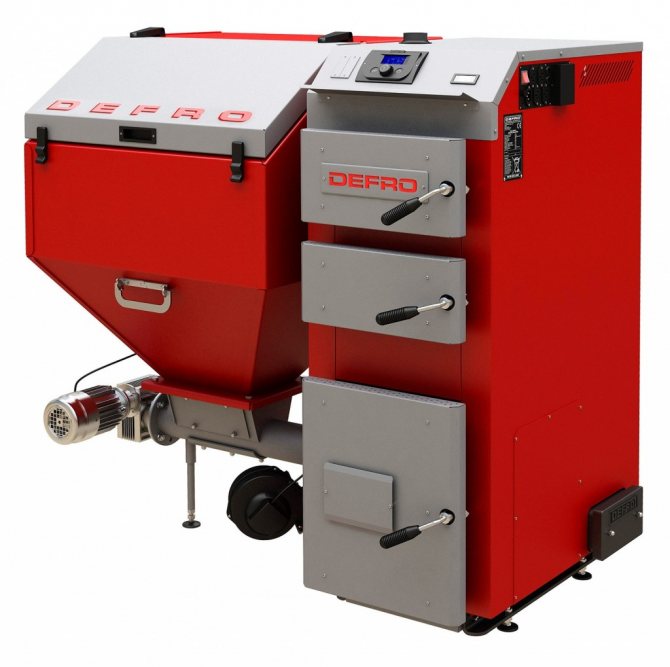

An important condition for the correct operation of the pyrolysis boiler is the moisture level of the fuel. The moisture content of the wood that will be put into such a boiler should not exceed 25%. Practice shows that firewood stored in a woodpile can boast such a percentage of moisture only 24 months after the start of storage. The boiler is also picky about the size of the fuel: the thickness of the wood that is being prepared for laying in such a boiler should not be less than 100 millimeters. The minimum boiler power, which can be considered controllable, is 50%, in cases where the boiler power drops below the indicated value, the operation of the device becomes unstable. This suggests that the boiler is well adapted for operation in cold periods of the year, however, it is completely unsuitable for efficient operation in the off-season.
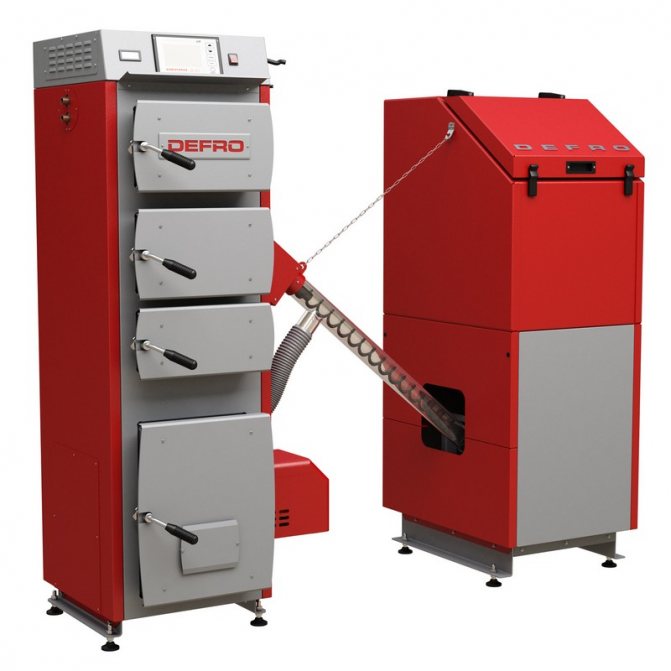

Pyrolysis boilers from manufacturers such as VERNER and ATMOS boast excellent reviews from users who have studied and tested this technique in the process of practical use.
Operating rules
To get good heat transfer from a gas generator heater with minimal fuel consumption, manufacturers recommend adhering to the following rules:
- use only dry wood, permissible moisture content 12 ... 20%;
- when installing and piping the boiler, it is imperative to use a three-way mixing valve or a complex Laddomat-21 device to maintain the return temperature at 65 ° C;
- operating temperature of the heating agent at the supply - 80 ... 90 ° C;
- the heat generator must operate at a power close to the maximum; it is impossible to operate the unit for a long time in a mode of low productivity (less than 50%);
- it is very advisable to drown with large logs, but not round logs;
- together with pyrolysis boilers, it is strongly recommended to use a buffer tank, which will accumulate excess thermal energy;
- the requirement for the minimum volume of the heat accumulator is 25 liters for each kilowatt of heater power.
Explanation. If a cold coolant with a temperature below 65 degrees goes into the boiler tank, then in the process of fuel gasification, condensate and tar will form in the primary chamber. Read more about the correct piping in a separate manual on connecting TT boilers.
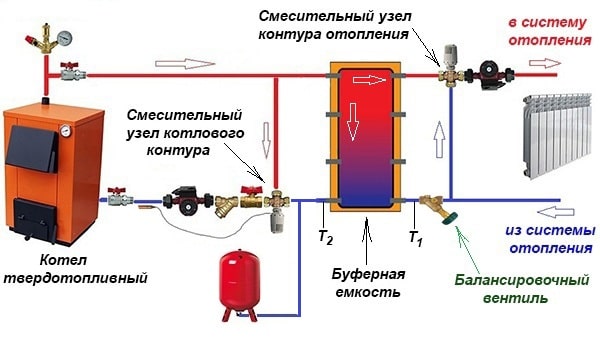

The heating agent supply to the boiler must be regulated by a three-way valve. After the buffer tank, another mixing unit is installed to lower the water temperature
The use of a buffer tank is due to the effective operating mode of the boiler - intensive combustion, outlet temperature 80 ... 90 degrees. It is under such conditions that a high efficiency of 86–87% is achieved. It is impossible to "choke" the heat generator through the air, the combustion efficiency will decrease to 40-50%, like in a homemade stove-stove.
The principle of operation of a long-burning solid fuel boiler.
Typically, these solid fuel boilers operate on the principle of "top combustion". How does a long burning boiler work? Before oxygen enters directly into the furnace, where combustion takes place, it is heated up. It is heated in order to ultimately reduce the amount of combustion waste: soot, ash. Oxygen is supplied not from bottom to top, but from top to bottom. Thus, only the top layer of solid fuel stored in the firebox burns. Due to the fact that the air enters from above, it does not penetrate downward and the combustion process is impossible there. Only the top layer of fuel burns. When the top layer burns out, feed to the bottom layer is turned on. So gradually, as the combustion progresses, the air is supplied lower and lower. Thanks to this approach, the top layer of fuel always burns, and the one below remains intact until it comes to its turn.This allows very economical consumption of fuel and control of the combustion process. It is with this technology that solid fuel burns for a very long time.
Such boilers are not only economical but also environmentally friendly. Of course, provided that fire-resistant building materials are used, which will not only ensure the maximum efficiency of the boiler, insulating heat, but also protect against possible fires.
You can clearly understand how the pyrolysis boiler works from this video:
The real benefits of pyrolysis heaters
Let's list the advantages of gasifying boilers, declared by sellers, and then we will weed out frank stories:
- pyrolysis heat sources are full-fledged gas generators emitting combustible synthesis gas;
- the units are very economical and environmentally friendly due to their high efficiency;
- boilers completely burns coal and firewood, practically without residue;
- burning time - over 10 hours (the most modest figure is 8 hours).
Note. Advertisers and not too conscientious manufacturers always compare gas generating units with conventional direct combustion boilers, "forgetting" about equally efficient pellet heaters. But even this comparison is not very winning.
The first statement is too bold. Let's remember: intense pyrolysis starts from strong heating and a lack of oxygen, but what happens in the boiler? The fan blows air into the firebox in excess, there is no smoldering. Synthesis gas, of course, is released, but direct fuel combustion is also present.
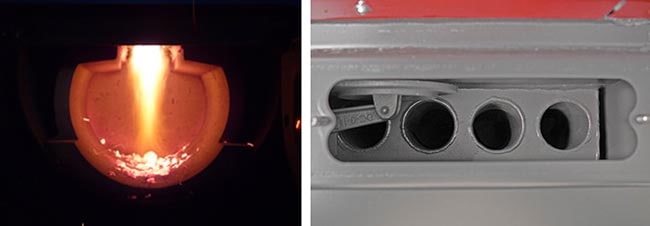

On the left is a flame torch in the afterburner compartment during boiler operation, on the right is a fire-tube heat exchanger (top view)
Let's take a look at the rest of the benefits:
- The statement about economy and environmental friendliness is not a fairy tale. Due to the decent efficiency, the boiler better assimilates the energy of the fuel and emits much less toxic compounds - nitrogen oxide and carbon monoxide - into the atmosphere. On condition 1: the recommendations on the operating mode and the moisture content of the firewood are fully observed.
- The reasons for a more complete combustion are dry wood and forced air injection. If you put sawdust briquettes or dry acacia into a traditional turbocharged boiler, then the ash residue will also be zero. A lot of light ash is simply blown out by a fan into the chimney. This means that this fact is not an advantage.
- The duration of combustion depends on 2 factors: efficiency and capacity of the fuel compartment. In terms of efficiency, solid fuel boilers lose to pyrolysis boilers by 10%, this is a small increase in the duration of operation. The main factor is the volume of the combustion chamber, if it reaches 80 liters or more, firewood will burn out in 6-8 hours.
Reference. The Czech manufacturer Atmos describes the advantages of its heat generators (literally): a large fuel bunker - a long burning time. Hence the conclusion: the statement about the duration of the work is true, only the reason is different - the capacity of the furnace, and not the fact of generating wood gas.
Also, a lot of fables are told about the economical mode of smoldering, which is simply absent in pyrolysis units. It is written in the operating instructions "Atmos DC15E" - a decrease in flame intensity leads to a decrease in efficiency and an increase in fuel consumption.
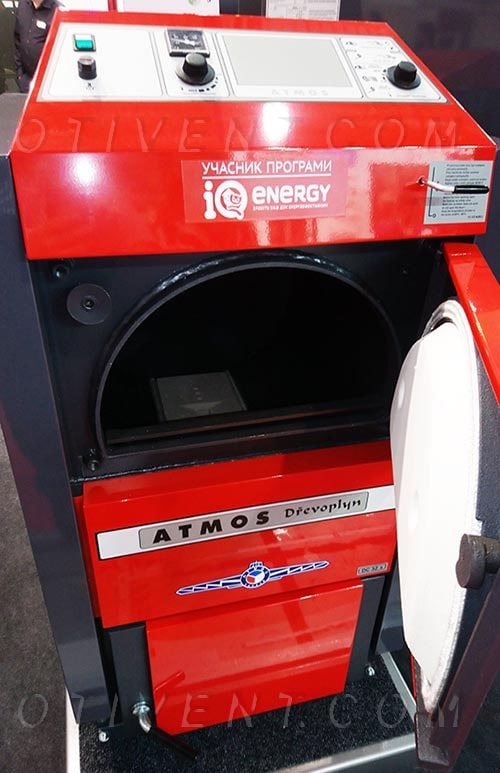

The newest heat generator "Atmos" of pyrolysis type at the exhibition "Aquatherm-2019"
Several schemes of the pyrolysis boiler device
Before proceeding with the manufacture of a gas-generating boiler with your own hands, you need to familiarize yourself with the possible options for its device. Such units can have a different design solution. But, in practice, their principle of operation is the same: they all have two fuel combustion chambers. The first of them, as a rule, serves for loading fuel and its pyrolysis combustion, and the second for burning the combustible gas released during pyrolysis.Depending on the design of the boiler, they can be of different shapes, sizes and take different positions relative to each other.
In addition, different models of pyrolysis boilers can differ in the way of supplying primary and secondary air: it can be natural or forced, with the help of a fan. Below, the most common schemes for the device of such boilers are considered, which can be used when building them with your own hands.
Pyrolysis boilers with natural air supply
Option 1.
The chamber for loading and pyrolysis fuel combustion is located below, and the pyrolysis gas afterburner is located above it (Fig. 1). The supply of primary and secondary air with such a scheme is carried out from below, through the blower door, which is connected by a chain with a sensor-regulator built into the "water jacket" of the boiler. Primary air is supplied through the blower chamber and the grate in such an amount as to ensure slow combustion of solid fuel with the release of combustible gas, which is fed into the upper chamber with the help of natural draft. Secondary air is preheated in the lower one and supplied to the upper chamber by means of tubes with calibrated holes, ensuring the gas combustion process.
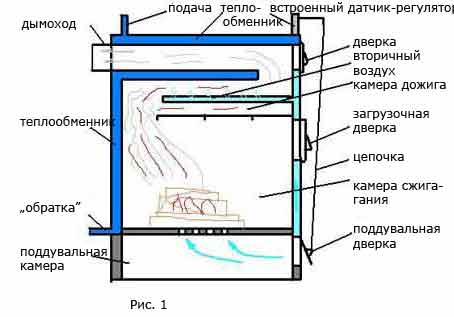

Fig. 1 Diagram of a pyrolysis boiler with natural air supply and an upper location of the afterburner
Option 2.
This scheme (Fig. 2) provides for the location of the fuel loading and pyrolysis combustion chamber at the top, and the gas combustion chamber at the bottom. When such a boiler is ignited, the throttle valve opens in its upper part and the fuel starts to burn as in a conventional solid fuel boiler, and the flue gases are emitted directly into the chimney. After the fuel ignites, the damper closes and the boiler starts operating in the gas generating mode: pyrolysis gas enters the lower chamber and burns there, releasing thermal energy and heating the coolant in its heat exchanger ("water jacket").
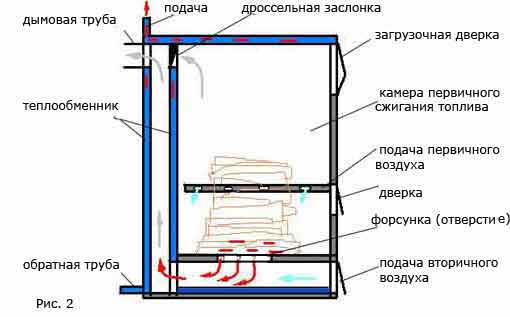

Fig. 2 Diagram of a pyrolysis boiler with an upper loading chamber and pyrolysis combustion
Option 3.
This scheme of the pyrolysis boiler differs from the previous one in that the loading door is located not on the side, but on top. In addition, the heat exchanger is supplemented with tubes that allow to increase the contact area with hot gases and increase the efficiency of heat transfer. The upper location of the loading door makes the process of loading fuel more convenient. In addition, if desired, such a chamber can be extended upward, thereby increasing the volume of simultaneously loaded fuel, and hence the duration of the boiler operation.


Fig. 3 Diagram of a pyrolysis boiler with a loading door on top
Option 4.
This scheme (Fig. 4) differs from others both in the location of the heat exchanger (in the upper part) and in the design of the combustion chambers themselves. Loading - made in the form of a bunker with an inclined base, which ensures spontaneous flow of fuel, as it burns out, to the place of primary combustion. The afterburner here is made in the form of a pipe made of refractory material and is located inside the feed hopper, above the primary combustion chamber. To increase the temperature in it and create better conditions for burning combustible gas, this design provides for heating its walls from the outside with part of the hot flue gases.
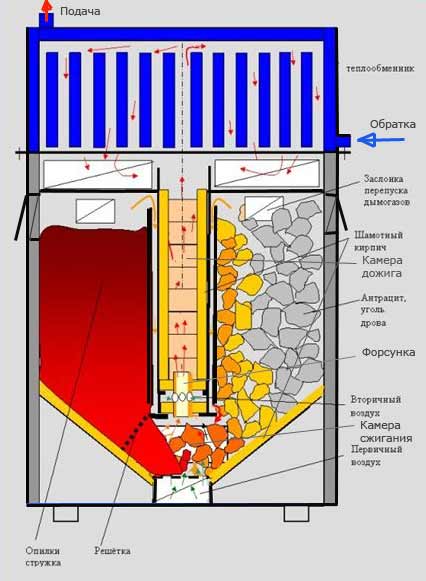

Fig. 4 Diagram of a pyrolysis boiler located at the top of the heat exchanger
Forced air pyrolysis boilers
Option 1.
The chamber for loading and primary combustion of fuel in this scheme is located at the bottom (Fig. 5). Its base is made of refractory material (for example: fireclay bricks) with openings for the supply of primary air from the blast chamber, which are located near the rear wall of the boiler.The supply of secondary air for combustion of wood gas is carried out using a fan installed on the front wall of the boiler, above the loading door.
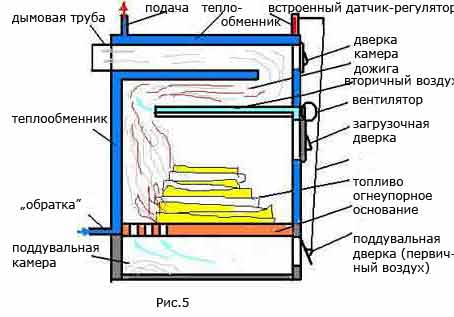

Fig. 5 Pyrolysis boiler with upper combustion chamber and forced supply of secondary air
Option 2.
This scheme (Fig. 6) differs in that the supply of air, both primary and secondary, is carried out using a fan located on the front wall of the boiler or on the chimney (smoke exhauster). Such a scheme allows more efficient regulation of the unit's operation, but is dependent on the availability of electricity. In addition, in the presented scheme, the overlap between the chambers is made of refractory material, in which there are channels for supplying secondary air and a nozzle for supplying pyrolysis gas to the lower combustion chamber is located.
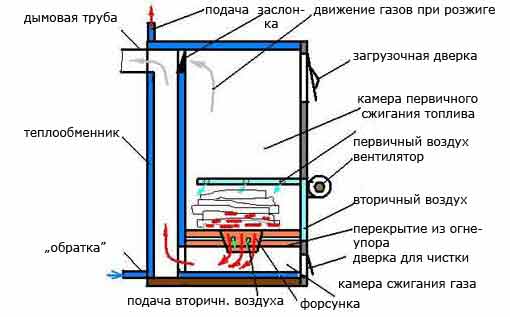

Fig. 6 Gas generator boiler with a lower gas combustion chamber and forced supply of primary and secondary air
Significant disadvantages of boilers
If you visit any online store of heating units and ask how much pyrolysis heat generators cost, you will immediately see their main drawback. Not the most expensive Russian boiler "Suvorov M" K-20 (20 kW) will cost 1320 cu. That is, and the ATMOS DC 20 GS, identical in power, is 2950 cu. e. For comparison: the price of an expensive traditional heater Buderus Logano S131-22 H is $ 1010. e.
Let's designate other disadvantages of gasifying heat sources:
- 2 chambers, brick or ceramic lining plus a water jacket in the lower part of the body - the above design solutions significantly increase the weight and dimensions of the units;
- high requirements for fuel quality;
- a coolant with a temperature of 80 ° C is rarely used when heating private houses, which means that you cannot do without an expensive heat accumulator + piping elements;
- ceramic parts of the lining do not last forever - the nozzle may crack from overheating and will have to be replaced.
I must say, pyrolysis boilers attract home craftsmen. But making such a unit with your own hands is very difficult, you need experience and investment in the purchase of materials. It will not be possible to make a heater for free. Much easier to weld a conventional or mine boiler.
Note. Judging by the reviews of the owners of the boilers on the thematic forums, it is still possible to use raw firewood. The algorithm is as follows: the unit is melted and warmed up with dry logs, then damp wood is thrown up. But the share of such fuel should not exceed 30%, otherwise soot and soot will go. Let's hear the expert's opinion on the video:
Conclusions and recommendations for choosing
It makes sense to choose pyrolysis boilers from all existing boilers in this situation:
- you are willing to pay for efficiency and environmental conservation;
- the budget allows you to purchase a heater and heat accumulator of the required volume;
- there is enough space for equipment in the boiler room;
- there is an opportunity to harvest high-quality firewood, buy briquettes or dry freshly cut wood.
The heat generator model is selected in terms of power and functionality. How to choose the right wood-fired heat source for your home, read our instructions.
Initially, pyrolysis household boilers are designed to install a storage tank and use good fuel. This is a Western European practice where solid fuel units cannot be operated without a buffer tank.
Our incomes are not so high, which is why homeowners save on everything - equipment, fuel, method of combustion. Hence the conclusion: at the moment, gas generators are incompatible with the needs and costs of most homeowners, because they will not be able to be properly operated.
